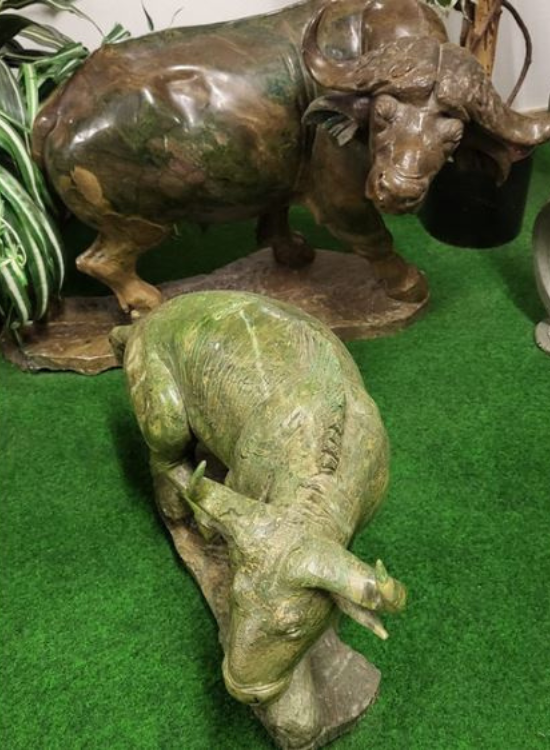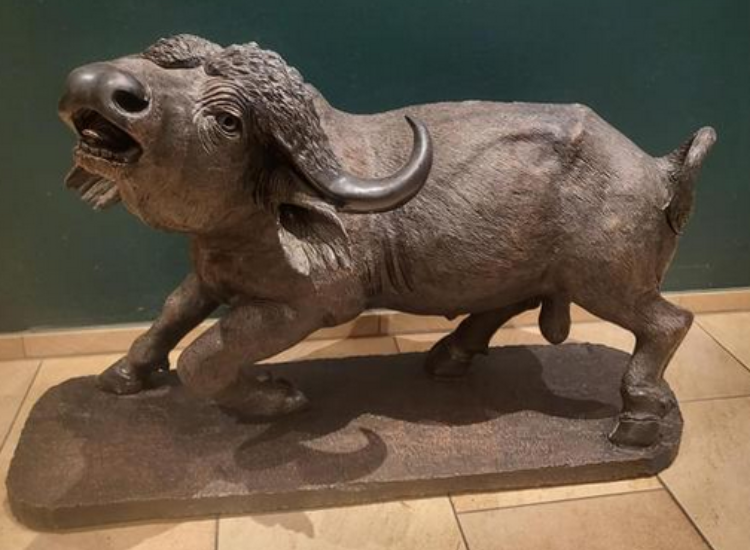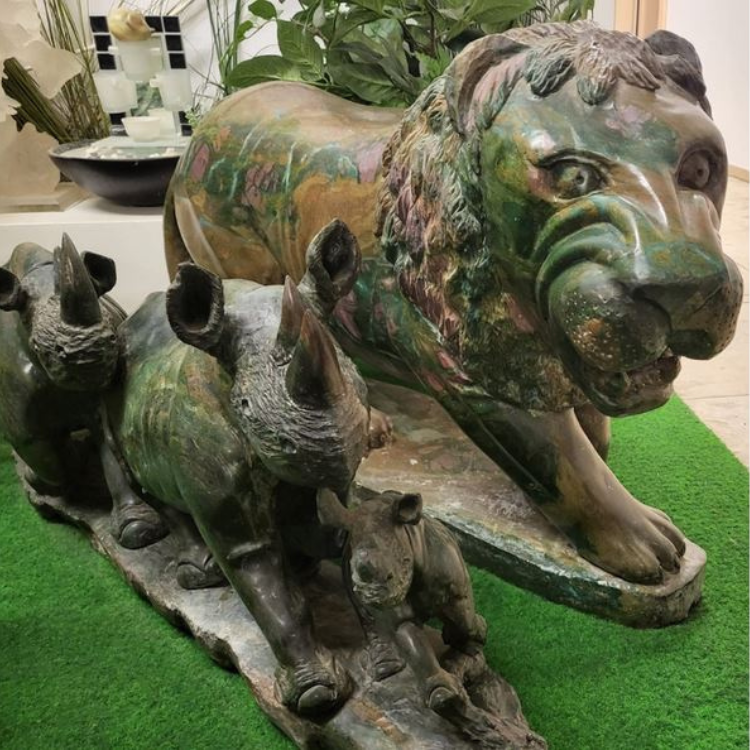Big 5
- Details
- Hits: 3082
African buffaloes, also known as simply buffaloes, are large hoofed mammals native to Africa and quite easy to see during your holiday safari in Zimbabwe. They play a crucial role in maintaining the balance of their habitats as successful grazers. These animals have strong social bonds and typically live in large herds. Hunting buffaloes can be challenging due to their unpredictable and aggressive behavior.
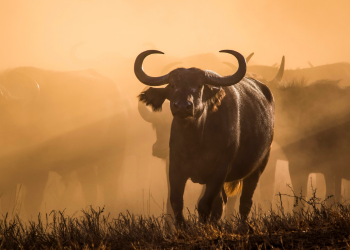
Buffalo weight varies based on factors such as age, gender, and health. On average, adult male buffaloes weigh between 500 to 1,000 kg (1,100 to 2,200 pounds) while females weigh between 225 to 500 kg (500 to 1,100 pounds). However, some individuals can reach up to 1,200 kg (2,600 pounds).
Buffaloes are known for their tough and persistent nature and can maintain a steady pace for a long distance, making them difficult to tire out. In addition to their land-based endurance, buffaloes are skilled swimmers and capable of crossing large bodies of water. Though slow on land, buffaloes are formidable and powerful animals that deserve respect and plenty of space.
Buffaloes are herbivores, meaning they mainly feed on vegetation. They are known to graze on grasses and consume other plants like herbs, shrubs, and leaves. Their diet can vary depending on the season and availability of food. During the rainy season, they have access to more food and tend to eat a wider variety of plants, while in the dry season, they rely mostly on grasses.
African buffaloes are fascinating animals to observe in their natural habitat. During the dry season, they can often be seen gathered around water sources, such as rivers and watering holes. Their herds can number in the hundreds, and watching them graze and interact with each other can be a mesmerizing experience.
Despite their majestic appearance, buffaloes can be dangerous when provoked. Encountering a buffalo in the bush during your holidays in Zimbabwe can be a hazardous situation, as these animals are known to be unpredictable and territorial. Here are some general guidelines to follow if you find yourself facing a buffalo:
Stay calm and quiet. Avoid making sudden movements or loud noises that could startle the buffalo.
Back away slowly. Slowly move away from the buffalo while keeping your eyes on the animal. Do not turn your back on the buffalo, as this can be interpreted as a threat.
Find cover. If possible, find cover behind a tree, rock, or other obstacle that can provide a barrier between you and the buffalo.
Be prepared to defend yourself. If the buffalo charges, use any available means to protect yourself, such as climbing a tree, using bear spray, or throwing rocks or sticks.
Seek medical attention if necessary. If you are injured by a buffalo, seek medical attention immediately, as these animals can transmit diseases and cause serious injuries.
When it comes to buffalo sightings, Zimbabwe is one of the best places to visit. Hwange National Park is "Home" to one of the largest populations of African buffaloes in the world, with an estimated 40,000 individuals. In addition to buffaloes, the park is also "Home" to a wide variety of other wildlife, including elephants, lions, and giraffes.
Buffaloes have also played an important role in Zimbabwean culture and art. Shona sculptures of buffaloes are highly sought after by collectors around the world. These sculptures are made from a variety of materials, including stone and wood, and often depict the animal's strength and power.
Whether you are a wildlife enthusiast, an art collector, or simply someone looking for an unforgettable holiday experience, African buffaloes are sure to leave a lasting impression. With their impressive size, strength, and social bonds, these animals are a true wonder of the African savannah.
Two different Shona sculptures of buffaloes - the stones are both green verdite.Stones used by Sculptors of Zimbabwe
Wooden Shona sculpture - Artist unknown.
Enjoy a short video of Buffaloes as a foretaste for your holiday to Zimbabwe. Should the item be blocked due to GDPR kindly click on Item. Here you can learn what GDPR is!
Read more: African Buffaloes: The Formidable Grazers of Zimbabwe
- Details
- Hits: 2927
Learn about the Largest Land Animals!

Elephants are fascinating creatures that have captured the imagination of people for centuries. They are the largest land animals on Earth, native to Africa and Asia. With their long trunks, elephants are known for their intelligence and strong social bonds. They are also vital to the ecosystem, playing a crucial role in maintaining the balance of their habitat through herbivory and seed dispersal.
During your holiday to Zimbabwe, during a safari, you can explore the world of elephants and witness their grandeur in their natural habitat. Zimbabwe is "Home" to two species of elephants, the African and Asian elephants, which differ in size and appearance. African elephants are larger and heavier than Asian elephants, weighing on average 7 tons (6,350 kg) and 5 tons (4,500 kg), respectively.
Despite their massive size, elephants are not built for speed and have slow, steady movements. They can reach a maximum speed of 40 km/h (25 mph) but typically move at a slower pace, around 25 km/h (15 mph). However, elephants are incredibly strong and powerful and can be dangerous when agitated. Their massive size and weight give them great momentum, making them difficult to stop once in motion.
Elephants are herbivores and their diet consists mainly of leaves, grasses, bark, fruits, and roots. They can consume up to 300 pounds of food in a single day. Adult elephants can eat up to 5% of their body weight in food, which can amount to more than 400 pounds of food per day. Interestingly, elephants can get drunk. In some regions, elephants have been known to consume fermented fruit from marula trees, which can have an intoxicating effect on them. The behavior of intoxicated elephants can be erratic and dangerous.
Elephants play a vital role in the ecosystem, and their decline due to habitat loss and poaching is a cause for concern. During your Zimbabwe holiday, you can visit a Safari park to witness the grandeur of elephants and other wild animals in their natural habitat. Always follow the guide's instructions for a safe and exciting experience.
If you encounter an elephant in the bush during your Zimbabwe holiday, it's important to remember that elephants are generally not aggressive towards humans, but they can be territorial and may charge if they feel threatened. Here are some tips to follow:
Stay calm and avoid sudden movements or loud noises. Speak softly and move slowly.
Keep a safe distance, ideally at least 30 meters away.
If the elephant is in a herd, do not get between the elephant and the rest of the herd. This can trigger a defensive reaction.
Avoid blocking the elephant's path or cutting off its escape route.
If the elephant is showing signs of agitation, such as flapping its ears, trumpeting or mock charging, back away slowly while keeping an eye on the animal.
If the elephant charges, do not run. Instead, stand your ground and try to make yourself look larger by raising your arms and jacket or backpack. Back away slowly, and avoid turning your back on the elephant.
If the elephant knocks you down, curl up in a fetal position and protect your head and neck with your arms.
Remember that it's always best to avoid disturbing wildlife in their natural habitat and to keep a safe distance from all wild animals. All wild animals are extremely dangerous.
During your Zimbabwe holiday, you can also learn about the fascinating relationship between elephants and dung beetles. Dung beetles play a vital role in the ecosystem by removing elephant dung, which helps to prevent the spread of disease and parasites. You can witness this relationship in action in the parks.
Finally, Zimbabwe is also "Home" to many talented sculptors who have been inspired by African elephants. You can collect Shona sculptures of this beautiful animal during your Zimbabwe holiday, which will ensure you will never forget the experience.
A very well-carved Shona sculpture of an elephant from green verdite. The sculptor is unknown to us. African elephants have been a great influence on the sculptors in Zimbabwe from the early days. Stones used by Sculptors of Zimbabwe. Stones used by Sculptors of Zimbabwe
and here a Shona sculpture in wood carved in Victoria Falls - Mosi-oa-Tunya - the place to absolutely visit
Painting by Barry Lungu - Shona artist from Harare Zimbabwe
A short video staring African Elephants - Come for a holiday to Zimbabwe Should the item be blocked due to GDPR kindly click on Item. Here you can learn what GDPR is!
Read more: Discover the Majestic Elephants during your Holidays to Zimbabwe
- Details
- Hits: 4334
During your holidays in Zimbabwe, on a safari, you will probably be able to see a lion or even a pack of lions. Lions are a majestic species of big cats found in Africa and India. These carnivorous predators play a crucial role in maintaining the balance of their ecosystem and are apex predators. They form social groups called prides, which are led by a dominant male. The distinctive mane and roar of lions make them well-known and sometimes referred to as the "king of the jungle," despite actually residing in savannas and grasslands. Due to habitat loss and hunting, lions are considered vulnerable to extinction.
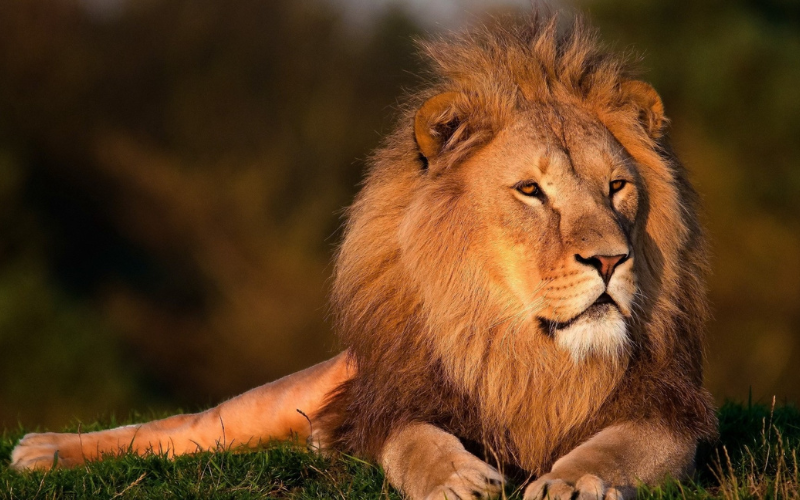
The lion, also known as Panthera leo, is one of the largest and most powerful cats in the world. Weighing between 330-550 pounds (150-250 kg), male lions are typically larger and heavier than females, averaging around 420 pounds (191 kg). However, a lion's weight can vary depending on factors like age, health, and habitat. Lions are also known for their speed and agility, making them one of the fastest big cats. They can run up to 50 km/h (31 mph) for short distances and make them successful hunters. Their speed and power make them formidable predators, capable of taking down prey much larger than themselves. Lions are also known for their endurance, and they can run at a steady pace for several kilometers, but typically hunt by sneaking up on their prey and relying on ambush.
Lions are carnivorous and primarily eat meat. They hunt and eat a variety of prey, including antelopes, zebras, giraffes, buffalo, and wild pigs. Lions are also known to scavenge, feeding on the remains of dead animals killed by other predators. Their sharp teeth and strong jaws make it easy for them to tear apart their prey and consume it quickly. However, hunting is not always successful, and lions can go without food for several days, especially during the dry season when prey is scarce.
If you ever find yourself facing a lion in the bush during your holiday in Zimbabwe, it's important to remain calm and avoid running, as lions can easily outrun humans. Running away may trigger their instinct to chase and attack. Instead, try to make yourself look bigger and more intimidating by raising your arms and opening your jacket if you have one. Speak firmly and loudly to the lion, but avoid making direct eye contact, as this can be interpreted as a sign of aggression. Remember that lions are not interested in humans as prey and will usually only attack if they feel threatened or cornered.
If the lion charges at you, stand your ground and continue to appear large and threatening. You can throw rocks or other objects at the lion to try and scare it away. If the lion attacks, try to protect your head and neck while fighting back as aggressively as possible. It's important to note that these situations are rare and that most encounters with lions are peaceful and safe, especially when you're on a guided safari.
In general, it's best to avoid getting too close to wild animals and to always respect their space and habitat. If you're going on a safari or other wilderness adventure, make sure to follow the guidance of trained professionals and always put your safety first. Wild animals are extremely dangerous, and it's important to remember that they are not domesticated pets.
During your holidays in Zimbabwe, you can visit a Safari park to see lions and other rare animals in their natural habitat. Zimbabwe is "Home" to several national parks, including Hwange National Park, Mana Pools National Park, and Matobo National Park, where you can go on guided safaris and see lions, elephants, zebras, and other wildlife up close. You can also collect a beautiful Shona sculpture of a lion during your trip to remember your holidays in Zimbabwe. Shona sculptures are made by local artists and are carved from a variety of stones, including green verdite, serpentine, and soapstone. They are unique and beautiful souvenirs that will remind you of your African adventure and holiday in Zimbabwe for years to come.
A short video of lions - enjoy your holiday in Zimbabwe.
Should the item be blocked due to GDPR kindly click on Item. Here you can learn what GDPR is!
- Details
- Hits: 3338
Leopards, known for their impressive climbing and swimming abilities, are a species of large carnivorous cats native to Africa and Asia. They are solitary hunters with a reputation for being elusive and reclusive, and their distinctive spotted coat provides camouflage in their natural habitats. They are difficult to spot but you might be lucky and see one during your holiday in Zimbabwe on safari.
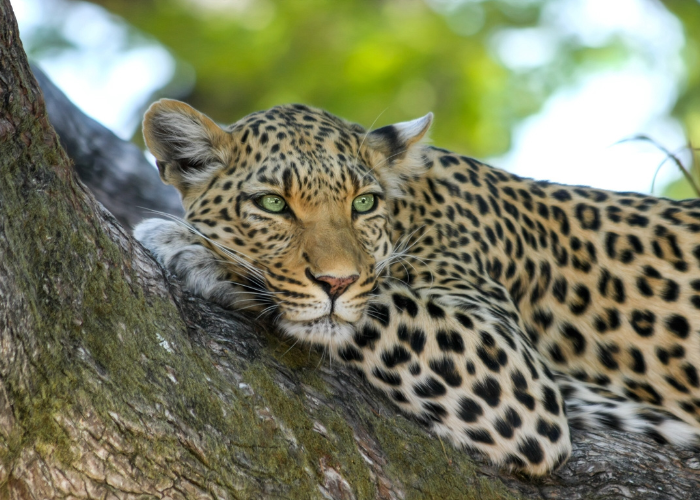
The weight of a leopard can range greatly, with adult males weighing between 70-200 pounds (32-90 kg) and females weighing between 60-165 pounds (27-75 kg). However, some leopards can weigh as much as 250 pounds (113 kg). They are lighter than other big cats, such as lions and tigers.
Leopards are known for their exceptional speed and agility, capable of running at speeds up to 60 km/h (37 mph) for short distances. Their stealth and power make them formidable hunters, and their agility enables them to climb trees and leap long distances with ease. Leopards are one of the most successful predators in the animal kingdom, thanks to their impressive combination of speed, power, and agility.
Leopards are carnivorous and eat a wide variety of prey, including small and large mammals such as rodents, hares, antelopes, monkeys, gazelles, impalas, wildebeests, and zebras. They are also known to prey on birds, reptiles, and fish, and have been known to hunt domestic livestock such as goats and sheep. Leopards are opportunistic predators and will take advantage of whatever prey is available in their environment.
If you find yourself facing a leopard in the bush during your holiday to Zimbabwe, it is important to remain calm and avoid any sudden movements. Leopards are generally shy and will try to avoid humans, but if they feel threatened, they may become aggressive.
Here are some tips on what to do if you encounter a leopard in the bush:
Don't run: Running may trigger the leopard's hunting instincts, and it may chase you. Instead, try to back away slowly and avoid turning your back on the leopard.
Make yourself look bigger: Raise your arms or jacket to make yourself look bigger and more intimidating. This may discourage the leopard from attacking.
Make noise: Yell, clap your hands, or make loud noises to scare the leopard away.
Use bear spray: If you have bear spray, you can use it to deter the leopard.
Seek shelter: If possible, climb a tree or seek shelter in a nearby vehicle or building.
Remember, it's always best to avoid close encounters with wild animals and to follow local safety guidelines when exploring in the bush. We suggest you collect a great Shona sculpture than to get too close to the wild animal. Wild animals are dangerous and in this way you can remember your holiday to Zimbabwe always.
A short video of Leopards - enjoy your holiday to Zimbabwe
Should the item be blocked due to GDPR kindly click on Item. Here you can learn what GDPR is!
- Details
- Hits: 2946
Rhinos are massive, plant-eating mammals found in Africa and Asia. There are five distinct species of rhinos, including the black and white rhino. They are notable for their sturdy skin and keratin horn, which helps them to maintain the balance of their habitats through grazing and seed dispersal.
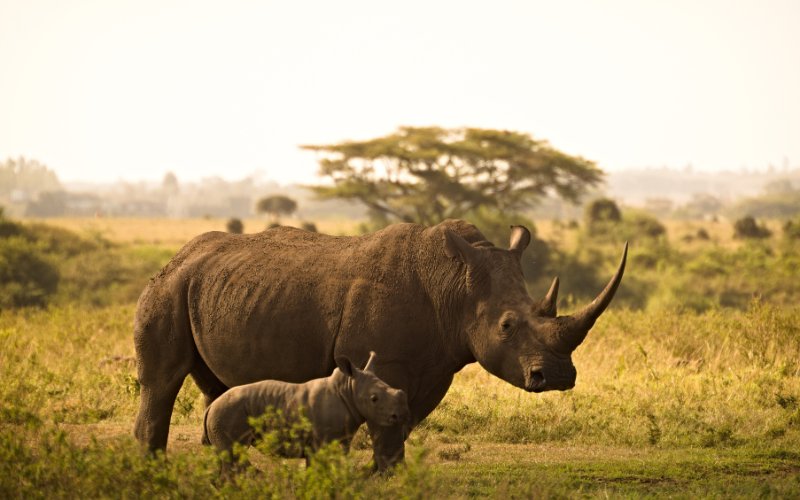
During your holidays in Zimbabwe, on a safari, you will have the opportunity to discover and see both the black and the white Rhino. The white rhino can reach up to 2,250 kg (5,000 lbs), while the black rhino weighs between 450 to 816 kg (1,000 to 1,800 lbs). Males tend to be larger, but weight varies based on factors such as age, health, and overall well-being. Rhinos are among the largest land mammals and are considered one of the most massive animals on earth.
Though they're not known for speed, rhinos are surprisingly nimble and can run up to 50 km/h (31 mph) for short distances, making them formidable when threatened. They're also highly agile and can make sharp turns and sudden movements, despite their slow speed. Rhinos should be respected and given ample space, as they are known to be aggressive when threatened and use their horn as a weapon.
Rhinos are herbivores and primarily eat grasses, leaves, shoots, and branches. The specific diet of a rhino depends on its species, habitat, and availability of food. Black rhinos, for example, eat a variety of woody plants, while white rhinos have a more grass-based diet. Rhino calves typically feed on their mother's milk for the first year of their lives.
The Rhino horn form is also used in the Mapiti art style. Shona sculpture is a popular art form in Zimbabwe, and many artists use the rhino as inspiration. For example, the Rhino Spirit Man Shona sculpture by Sampson Kuvenguhwa is a beautiful example of this art form.

If you find yourself facing a rhino in the bush during your holidays in Zimbabwe, it's important to remain calm and still. Do not run, as the rhino can charge at speeds of up to 35 mph (56 km/h), and its sharp horn can cause serious injuries or death.
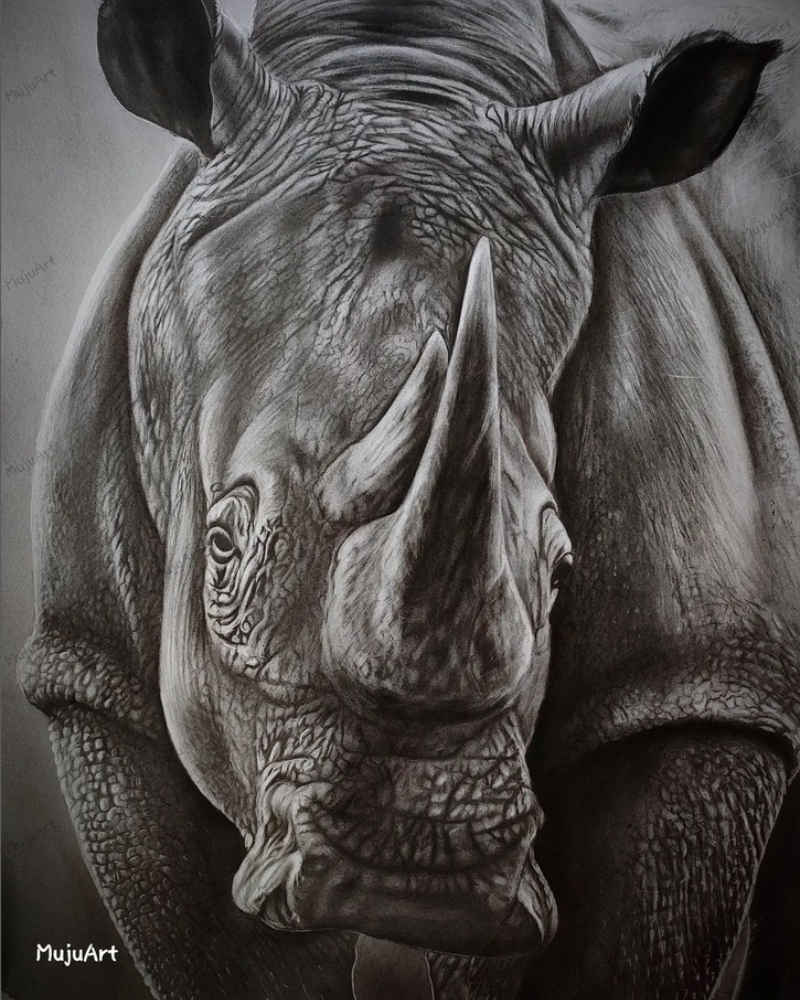
The Rhino
Charcoals on paper
Rhinos are gentle creatures. ❤️ It's so sad that these innocent beautiful animals are on verge of extinction....lest we join hands and protect them.
They have been around for millions of years and their only real threat is humans.
Say no to poaching.
I just played my part as a pencil Knight , play yours. ❤️ Tonderai Mujuru
Here are some tips to help you stay safe when encountering a rhino:
Stand your ground: Try not to move, and avoid making loud noises or sudden movements that may agitate the animal.
Give the rhino space: If possible, slowly back away while keeping an eye on the rhino. Keep a distance of at least 30 meters (100 feet) or more, and avoid getting between a female rhino and her calf.
Be aware of your surroundings: Look for nearby trees, rocks, or other objects that you can use as a barrier or hiding spot in case the rhino charges.
Avoid direct eye contact: Direct eye contact can be seen as a threat to the rhino, so it's best to keep your gaze down or to the side.
Seek help: If the rhino charges and you are unable to escape, try to find a tree or other solid object to hide behind. If you have a mobile phone or other means of communication, call for help immediately.
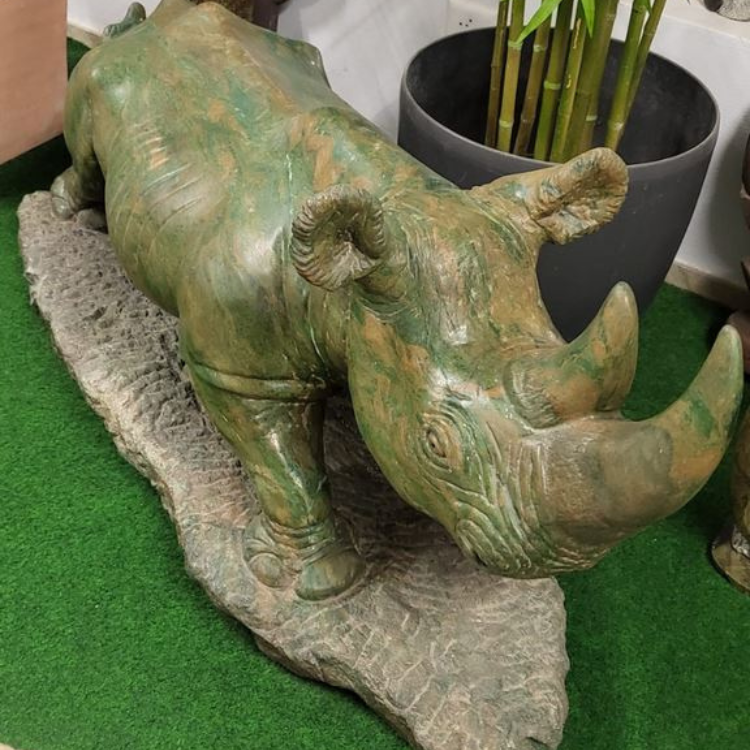
Shona sculpture - Stones used by Sculptors of Zimbabwe
It is also more sensible to collect a good Shona sculpture of a Rhino during your holidays in Zimbabwe than to get too close to the animals. Wild animals are dangerous!
Enjoy a short Video on Rhinos in their natural habitat. Should the item be blocked due to GDPR kindly click on Item. Here you can learn what GDPR is!
Read more: Discovering Rhinos during your Holidays in Zimbabwe

